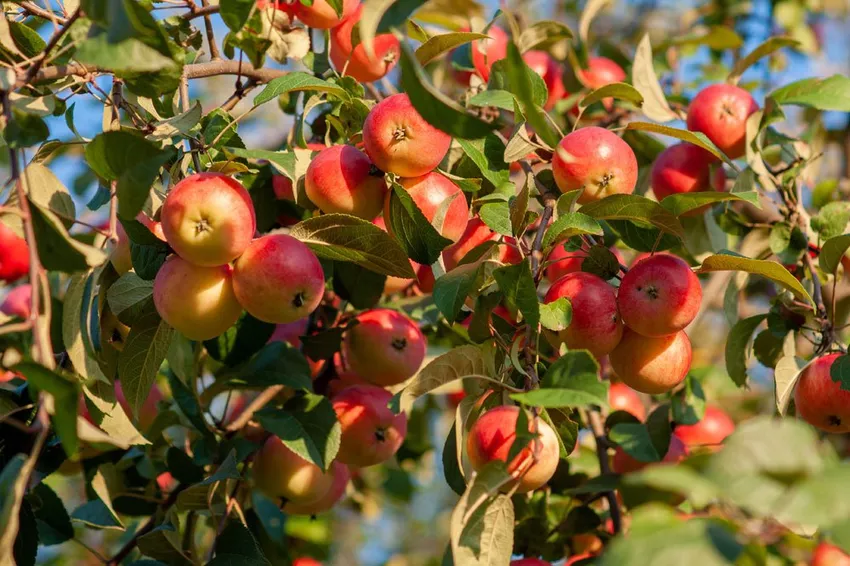If the apple tree has become too expansive in its previous location, it should be transplanted. You can find out how to do this correctly here.
 During the house construction phase, many people mean well and give away trees, shrubs and plants to the future homeowners. To prevent these plants from dying, they are planted in a place where they think it could fit.
During the house construction phase, many people mean well and give away trees, shrubs and plants to the future homeowners. To prevent these plants from dying, they are planted in a place where they think it could fit.
Apple trees, in particular, become quite expansive over the years. The crown can be up to 10 meters wide. If the apple tree was then planted too close to the house, things will get tight. The tree has to go. But is it that easy? Can you transplant an apple tree? Yes you can. But it requires good preparation.
Replanting apple trees correctly - tips & instructions
If the apple tree is only three to four years old, you can transplant it with a clear conscience. However, the longer the tree is in place, the more rooted it is. The chance that it will grow again at the new location is significantly lower. Because as with the crown, the roots get wider and deeper over the years.
❀ Apple Tree Root Types
The tree consists of different roots, each with a different function. The root system consists of main and secondary roots and so-called fine roots. These absorb the water from the earth and pass it on to the main and secondary roots, which collect it and then pass it on to the trunk.
The longer the tree is rooted, the further away the fine roots grow. If you now dig up the apple tree, the root system often only has main and secondary roots. In most cases, the fine roots grow back fairly quickly. However, there are also sensitive trees that may have problems growing because the water supply has stopped.
» Tip: Arborists therefore replant their trees every three years or pierce the roots so that the fine roots cannot go so far.
❀ Transplanting apple trees - explained step by step
The best time to transplant the apple tree is autumn. This allows the roots to get used to the new environment without being damaged by the frost.
Step 1: Uncover the apple tree
Dig a trench about the size of the treetop with a sharp spade. The vital fine roots are finally in the outer area. You should also be as generous as possible with the depth. In this way you can be sure that the apple tree still has all the necessary roots during the transplanting phase in order to be able to grow optimally at the new location.
Step 2: Dig the planting hole
Find a suitable spot for your apple tree. For the harvest yield and the taste of the fruit, it is extremely important, especially with apples, that they have a sunny location. So dig a planting hole corresponding to the root and improve the soil with some mature compost.
Step 3: Secure the apple tree against transport damage
To ensure that nothing happens to the apple tree during transport, you should secure the tree with a rope. To do this, tie the rope around the branches and tie everything sufficiently tight.
Step 4: Uncover the roots
There is a lot of soil between the individual roots, which makes transport unnecessarily difficult. So reduce the root ball by loosening the soil with a digging fork and removing excess soil.
Step 5: Move apple tree
Now you can transport your apple tree to the new location. Make sure, however, that the tree is only planted as deep as it was before. You can now insert a stake on the east side to give the tree the necessary stability. Tie the stake to the tree with coconut rope. Wrap the stretchable rope around the tree and pole in a figure of eight. The gaps are then wrapped and the ends tied tightly.
» Coconut rope is available cheaply from Amazon
Step 6: Fill the planting hole
Finally fill the planting hole with the compost. Gently tread down the soil and water the tree well. So that the apple tree grows optimally and also bears a rich harvest in the coming years, you should now make sure that it is watered regularly. But that doesn't mean that you have to dump lots of watering cans of water on the ground every day. On the contrary, every 2 to 3 days is quite enough. Water too much and too often, the roots will rot and the tree will die.
» My tip: If you are unsure about watering, you can dig a small hole near the tree. If the soil is still moist at 4 inches (10 centimeters), then there is no need to water.